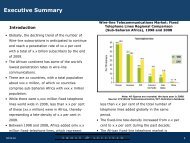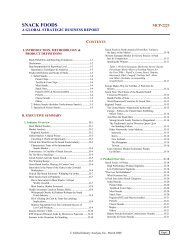the RUSSIA oil & gas competitive intelligence report - Report Buyer
the RUSSIA oil & gas competitive intelligence report - Report Buyer
the RUSSIA oil & gas competitive intelligence report - Report Buyer
Create successful ePaper yourself
Turn your PDF publications into a flip-book with our unique Google optimized e-Paper software.
Russia Oil and Gas Competitive Intelligence <strong>Report</strong> 2010<br />
transporting <strong>oil</strong> to Asia. The pipeline has experienced serious delays due to construction difficulties,<br />
environmental concerns and price disputes, but received a much-needed boost from a US$10bn Chinese<br />
loan in February 2009.<br />
ESPO is being built in two stages. The first 2,757km stage will link Taishet in <strong>the</strong> Irkutsk region to<br />
Skovorodino in <strong>the</strong> Amur region and has capacity of 600,000b/d. From Skovorodino, ESPO will branch<br />
out to China, via a 70km connector, which will supply nor<strong>the</strong>rn China with 300,000b/d from 2011. The<br />
first section of <strong>the</strong> pipeline had to be moved to 400km away from <strong>the</strong> ecologically sensitive Lake Baikal,<br />
missing <strong>the</strong> end-2008 deadline by a year and coming online in late-2009.<br />
The second leg of ESPO will cover 2,100km from Skovorodino to Kozmino on <strong>the</strong> Pacific and will<br />
increase <strong>the</strong> capacity of <strong>the</strong> entire pipeline to 1.6mn b/d. The second phase is not expected to be<br />
completed until 2014/2015. ESPO will be supplied primarily by Russian <strong>oil</strong> companies Rosneft, TNK-<br />
BP and Surgutneftegaz from untapped fields in East Siberia. It is hoped that this will allow Russia to<br />
replace dwindling output from West Siberia. Until ESPO Phase 2 comes online, <strong>oil</strong> from Skovorodino is<br />
transported by rail to <strong>the</strong> Pacific port of Kozmino for export.<br />
On August 29 2010, Vladimir Putin officially inaugurated <strong>the</strong> Russian section of <strong>the</strong> ESPO pipeline spur<br />
from Skovorodino to <strong>the</strong> Chinese city of Daqing. The 70km pipeline will run to <strong>the</strong> Chinese border,<br />
where it will connect with <strong>the</strong> 927km Chinese section of <strong>the</strong> spur, whose construction was completed in<br />
June 2010. The pipeline is expected onstream by October 31 2010, and will supply CNPC with<br />
300,000b/d in 2011-2030.<br />
Purpe-Samotlor<br />
Transneft began constructing a new major link from <strong>the</strong> Yamal Autonomous District in March 2009. The<br />
430km Purpe-Samotlor pipeline will provide a better export route from crude volumes from <strong>the</strong> giant<br />
Vankor <strong>oil</strong> field and will speed up <strong>the</strong> development of o<strong>the</strong>r deposits in <strong>the</strong> Yamal and north-western<br />
Krasnoyarsk regions. The pipeline will run from <strong>the</strong> village of Purpe to <strong>the</strong> Samotlor <strong>oil</strong> field in <strong>the</strong><br />
Khanty-Mansiysk region fur<strong>the</strong>r south. The link will cost US$1.34bn and is due to be commissioned in<br />
2012. Initial capacity will be 500,000b/d, which could be expanded at a later date.<br />
The Purpe-Samotlor pipeline will replace <strong>the</strong> longer and smaller-diameter lines for transporting Vankor<br />
crude. The new link will cut about 100km from Vankor's route to ESPO trunkline. As well as providing<br />
transit capacity for fur<strong>the</strong>r expansion at Vankor, it will benefit TNK-BP's Suzun, Tagul and Russkoe field<br />
developments on <strong>the</strong> Yamal peninsula.<br />
Baltic Pipeline System<br />
The Baltic Pipeline System (BPS) has two phases: BPS-1 and BPS-2. The pipelines transport <strong>oil</strong> from<br />
West Siberia and <strong>the</strong> far north of <strong>the</strong> country to <strong>the</strong> Baltic Sea terminal of Primorsk. The pipeline system<br />
began operations in 2001 and reached its full design capacity in 2006. Construction of a second phase of<br />
<strong>the</strong> network, known as BPS-2, started in June 2009. The pipeline was designed to expand <strong>the</strong> existing<br />
© Business Monitor International Ltd Page 71









